In the intricate dance of BDSM (Bondage, Discipline, Sadism, and Masochism), participants often talk about hard limits and soft limits, defining what they are willing to explore and what is off-limits. Soft limits, in particular, occupy a fascinating gray area, offering a unique blend of apprehension and potential for growth. This article delves into the concept of soft limits within the BDSM community, providing insights into how they can be navigated, communicated, and respected in a way that enriches the dynamic between partners.
In any BDSM relationship, consent is the cornerstone of trust and respect. It’s more than just saying “yes” or “no”—it’s about openly communicating your desires, limits, and expectations. But trust doesn’t end with a conversation—it’s built through ongoing, clear agreements. That’s where our Dominant & Submissive BDSM Contract Pack comes in. Find out more →
Understanding Soft Limits
Soft limits represent activities or practices in BDSM that an individual is hesitant about or uncomfortable with but may be willing to explore under certain conditions. Unlike hard limits, which are non-negotiable boundaries that must not be crossed, soft limits are fluid and can change over time. They encapsulate the evolving nature of human sexuality and the complex fabric of trust and communication that BDSM relationships are built upon.
The Significance of Soft Limits
Soft limits are more than just a list of potential activities; they are a gateway to deeper understanding and intimacy between partners. Acknowledging and respecting soft limits can significantly enhance the trust and communication within a BDSM dynamic. They offer opportunities for exploration, pushing boundaries safely, and discovering new aspects of one's sexuality and limits.
Identifying Your Soft Limits
Identifying one's soft limits requires introspection and self-awareness. It involves distinguishing between what genuinely evokes interest or curiosity and what elicits discomfort or fear. This process is personal and can vary greatly from one individual to another, emphasizing the uniqueness of each BDSM journey.
Communicating Soft Limits
Effective communication is the cornerstone of any healthy BDSM relationship, especially when it comes to negotiating soft limits. Here are some strategies for discussing soft limits:
Looking for the best BDSM & Kink OnlyFans content creators? Here is a list of of our favourites that you will love:
-
- Best BDSM & Fetish OnlyFans - Molly✨ >> Link
- Best BBW & Huge Ass OnlyFans - Naughty Hanna Zimmer 💜🎀 >> Link
- Best Sexy Gaming Nerd OnlyFans - 🎮 Gracy EstuSWEET 🎮 >> Link
- Best Fetish & Kink Messaging OnlyFans - 💫Lola La Fleur 💫 >> Link
- Best Girl Next Door OnlyFans - ☀️Lily ⛅ >> Link
- Best Tiny European OnlyFans - 💝 Ami Allison 💝 >> Link
- Best Cosplay OnlyFans - 🐱 Little Kitty Kate 👉👌 >> Link
- Best Little OnlyFans - 🧸 Katya 🙇♀️ Sun >> Link
- Best Sub OnlyFans - 🍌Hanna Banana🍌 >> Link
- Best Teen & Huge Tits OnlyFans - ❣️Anny❣️19 y.o. BUSTY student girl >> Link
- Best Tiny Tits OnlyFans - ⍣⭐️ Sofia Parker ⭐️⍣ >> Link
- Best Sub & Huge Boobs OnlyFans - Nika Huge Boobs >> Link
- Best Kink OnlyFans - Sofia💖 >> Link
- Best Fetish & Girl Next Door OnlyFans - Hillary is Wet 💦 >> Link
- Best Dirty Latina OnlyFans - Paula Flores 😈 >> Link
Not quite what you are looking for? View the full list →
- Open and Honest Dialogue: Begin with a conversation where both partners feel safe and respected. Express your feelings, concerns, and curiosity about specific activities or practices.
- Use of Safewords: Establish clear safewords to signal when an activity approaches or crosses a comfort threshold.
- Gradual Exploration: Agree to explore soft limits gradually, with mutual consent and an understanding that either partner can halt the activity at any time.
The Role of Negotiation
Negotiation is crucial in BDSM dynamics, particularly regarding soft limits. This process ensures that all activities are consensual and that both partners have a clear understanding of each other's boundaries and desires. Negotiation should be ongoing, as soft limits can evolve with experience and trust.
Respecting and Pushing Soft Limits
Respecting soft limits is about acknowledging and honoring your partner's current boundaries while also recognizing the potential for growth. Pushing soft limits should always be done with consent and care, ensuring that it's a mutually agreed-upon exploration.
Safety First
When exploring soft limits, prioritize safety—both emotional and physical. This means having a clear plan for aftercare and being prepared to address any emotional fallout or discomfort that may arise from pushing these boundaries.
The Importance of Aftercare
Aftercare is vital in BDSM, especially after engaging with soft limits. It involves taking care of each other emotionally and physically, providing comfort, and discussing the experience. Aftercare helps partners process their feelings, reaffirm their connection, and learn from the experience.
The Dynamic Nature of Soft Limits
Soft limits are not static; they can and often do change over time. Regular check-ins and discussions can help partners keep track of how their soft limits are evolving. This dynamic nature of soft limits reflects the growth and deepening trust between partners in a BDSM relationship.
Learning from Experience
Each exploration of a soft limit is an opportunity to learn—about oneself, one's partner, and the dynamics of their relationship. These experiences can lead to a richer, more nuanced understanding of one's desires and boundaries.
Soft limits in BDSM are a testament to the complexity of human sexuality and the depth of trust and communication required in these dynamics. They offer a unique opportunity for exploration, growth, and intimacy, challenging partners to navigate their boundaries thoughtfully and respectfully. By understanding, communicating, and respecting soft limits, individuals can forge deeper connections and embark on a journey of mutual discovery and fulfillment. Remember, the exploration of soft limits is a journey, not a destination, requiring patience, trust, and open communication. Embrace the adventure with an open heart and an open mind, and let the exploration of soft limits enrich your BDSM experience in ways you never imagined.
Frequently Asked Questions
What is a BDSM contract?
A BDSM contract is a document that outlines the details of the power exchange and the expectations between parties involved in a BDSM relationship. This includes the roles, limits, safewords, duration, and specific activities agreed upon. While not legally binding, it's a tool used to ensure clear communication and consent.
Is a BDSM contract legally binding?
No, a BDSM contract is not legally binding. It is a symbolic agreement between consenting adults meant to establish understanding and trust, but it does not hold legal weight in court.
Why are BDSM contracts important?
BDSM contracts are important because they ensure all parties are explicit about their boundaries and consent to the activities within the relationship. They foster open communication, clarify expectations, and provide a reference for the agreed terms of the relationship.
How do I negotiate a BDSM contract?
Negotiate a BDSM contract by discussing your limits, desires, roles, and expectations with your partner. Communication should be open and honest, with both parties feeling free to express their boundaries and interests. It's advisable to negotiate when not in a play session to ensure clear-headedness and mutual respect.
What should be included in a BDSM contract?
A BDSM contract should include the names or pseudonyms of the parties, roles (Dominant/submissive), duration of the contract, limits, safewords, rules, and expectations for behavior and punishment. It can also include provisions for health and safety, and any other agreements specific to your relationship.
Can a BDSM contract be modified?
Yes, a BDSM contract can and should be modified if the needs or boundaries of either party change. It's a living document that reflects the dynamics of the relationship and can be revisited periodically or when necessary.
What are hard and soft limits?
Hard limits are non-negotiable boundaries that must not be crossed under any circumstances, while soft limits are areas of discomfort that one may be open to exploring with care and clear consent. Both should be respected and reviewed in a BDSM contract.
What is a safeword?
A safeword is a predetermined word or signal that is used by a participant in a BDSM scene to immediately halt all activities. It's a critical safety mechanism used to ensure that all play remains consensual.
How does trust factor into a BDSM relationship?
Trust is the cornerstone of a BDSM relationship. It allows participants to be vulnerable and ensures that boundaries are respected. Establishing trust is a gradual process, built through honest communication, respect, and mutual care.
What is a power dynamic in BDSM?
A power dynamic in BDSM refers to the deliberate and consensual exchange of power between individuals. One party, typically the Dominant, takes control, while the other, the submissive, relinquishes control within the agreed terms of their relationship.
How do you ensure safety in a BDSM scene?
Safety in a BDSM scene is ensured by pre-negotiating activities, establishing safewords, respecting limits, and continuously communicating. It's also important to be educated on the safe execution of practices and to use common sense and ensure physical safety through the use of protective gear as necessary.
Is consent in BDSM different from consent in other contexts?
Consent in BDSM involves the same core principle as in other contexts—clear and enthusiastic agreement to the activities—but often requires more detailed negotiations due to the nature of the activities involved. Consent in BDSM is ongoing and can be withdrawn at any time.
How do experience levels impact a BDSM relationship?
Experience levels can significantly impact a BDSM relationship, as they affect the understanding and execution of practices. It's important for parties to be honest about their experience level and to engage in activities that are safe and comfortable for all involved.
Can a submissive say no?
Yes, a submissive can always say no. The foundation of BDSM is consent, and if a submissive does not consent to an activity or is uncomfortable, they have the right to refuse, use their safeword, or withdraw consent at any time.
What are aftercare practices?
Aftercare practices are the actions taken after a BDSM scene to care for the physical, emotional, and psychological well-being of all participants. This can include cuddling, debriefing the scene, providing a blanket or drink, or anything else that helps participants to feel safe, valued, and cared for.
What is the significance of collars in BDSM?
Collars in BDSM sometimes symbolize the relationship and dynamic between a Dominant and a submissive, similar to a wedding ring in a traditional marriage. The meaning can vary widely between relationships, from representing ownership and submission to being merely decorative.
How do you practice BDSM responsibly?
Practice BDSM responsibly by following the principles of safe, sane, and consensual (SSC) or risk-aware consensual kink (RACK), ensuring informed consent, setting clear boundaries, communicating effectively, and educating oneself on safe practices.
Can BDSM be therapeutic?
Some people find BDSM activities to be therapeutic, as they can involve the release of stress, the exploration of trust, and the expression of sexuality in a safe and consensual environment. However, BDSM is not a substitute for professional therapy.
Is jealousy common in BDSM relationships?
Jealousy can be common in BDSM relationships, as in any relationship. It's important to address feelings of jealousy openly and honestly, establishing clear boundaries, and ensuring that communication is prioritized to navigate these emotions healthily.
Do I need to have a BDSM contract to be in a Dominant/submissive relationship?
While a BDSM contract is not a requirement for a Dominant/submissive relationship, many find it helpful for structuring the relationship and establishing a clear, communicative framework. It's a personal choice based on the needs and preferences of those involved.
Can anyone participate in BDSM?
Anyone can participate in BDSM as long as they are a consenting adult who understands the responsibilities and risks involved. It's important for all participants to be fully informed and consensual about the activities they are engaging in.
As you embark on your BDSM journey, remember the importance of soft limits in fostering personal growth and exploring new sensations. At Filthy Adult, we strive to promote a safe and pleasurable experience within the BDSM and kink world. Be sure to explore our extensive collection of erotic art prints, comprehensive BDSM contracts, and a wide range of exciting products in our online fetish shop. Share this article with others who may benefit from our expertise and don't forget to check out our other informative guides on Filthy Adult. Unleash your desires, communicate openly, and embrace the power of soft limits in your BDSM play.













